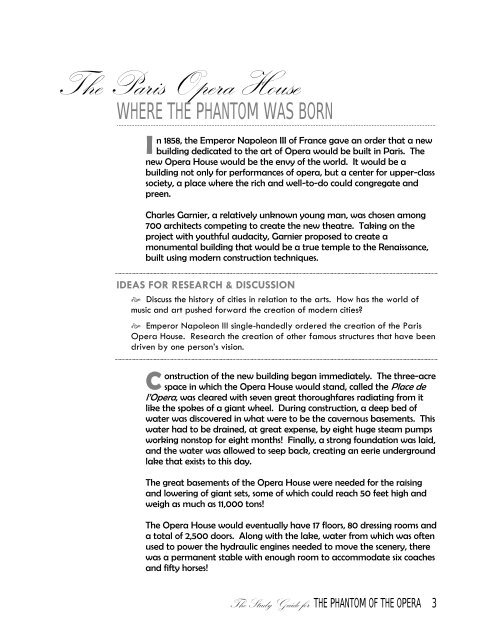Cameron Mackintosh And The Really Useful Theatre ... - Telecharge
Cameron Mackintosh And The Really Useful Theatre ... - Telecharge
Cameron Mackintosh And The Really Useful Theatre ... - Telecharge
Create successful ePaper yourself
Turn your PDF publications into a flip-book with our unique Google optimized e-Paper software.
<strong>The</strong> Paris Opera House<br />
WHERE THE PHANTOM WAS BORN<br />
.......................................................................................................................................................................................................<br />
I<br />
n 1858, the Emperor Napoleon III of France gave an order that a new<br />
building dedicated to the art of Opera would be built in Paris. <strong>The</strong><br />
new Opera House would be the envy of the world. It would be a<br />
building not only for performances of opera, but a center for upper-class<br />
society, a place where the rich and well-to-do could congregate and<br />
preen.<br />
Charles Garnier, a relatively unknown young man, was chosen among<br />
700 architects competing to create the new theatre. Taking on the<br />
project with youthful audacity, Garnier proposed to create a<br />
monumental building that would be a true temple to the Renaissance,<br />
built using modern construction techniques.<br />
IDEAS FOR RESEARCH & DISCUSSION<br />
� Discuss the history of cities in relation to the arts. How has the world of<br />
music and art pushed forward the creation of modern cities?<br />
� Emperor Napoleon III single-handedly ordered the creation of the Paris<br />
Opera House. Research the creation of other famous structures that have been<br />
driven by one person’s vision.<br />
C<br />
onstruction of the new building began immediately. <strong>The</strong> three-acre<br />
space in which the Opera House would stand, called the Place de<br />
l’Opera, was cleared with seven great thoroughfares radiating from it<br />
like the spokes of a giant wheel. During construction, a deep bed of<br />
water was discovered in what were to be the cavernous basements. This<br />
water had to be drained, at great expense, by eight huge steam pumps<br />
working nonstop for eight months! Finally, a strong foundation was laid,<br />
and the water was allowed to seep back, creating an eerie underground<br />
lake that exists to this day.<br />
<strong>The</strong> great basements of the Opera House were needed for the raising<br />
and lowering of giant sets, some of which could reach 50 feet high and<br />
weigh as much as 11,000 tons!<br />
<strong>The</strong> Opera House would eventually have 17 floors, 80 dressing rooms and<br />
a total of 2,500 doors. Along with the lake, water from which was often<br />
used to power the hydraulic engines needed to move the scenery, there<br />
was a permanent stable with enough room to accommodate six coaches<br />
and fifty horses!<br />
<strong>The</strong> Study Guide for THE PHANTOM OF THE OPERA 3





